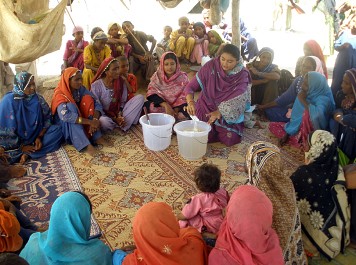
In July 2010, heavy monsoon rains began falling across Pakistan and flooded the entire Indus River basin. By early August, approximately one-fifth of Pakistan lay under water. The floods killed nearly 2,000 people and directly affected the lives of about 20 million others as they destroyed property and livelihoods and left people without food, shelter, or safe drinking water. After viewing the scene in August, USAID Administrator, Rajiv Shah, pointed out that "…more than nine million people are in need of immediate support, whether it is food, clean drinking water, medicines, a safe place to stay, or shelter for children and families."
Working closely with the USAID/Pakistan mission, USAID's Office of U.S. Foreign Disaster Assistance (OFDA) responded to the crisis with more than $400 million in disaster assistance including emergency food, shelter, sanitation, drinking water, and other supplies. The mission also re-focused pre-flood, long-term development projects to respond to the challenge and programmed additional funding provided by the State Department.
In the water sector, flood waters swamped wells, destroyed pipes and taps, and contaminated rivers and ponds with bacteria and sediments. To address the resulting drinking water and sanitation crisis, USAID and its implementing partners rehabilitated pumps and wells, provided emergency water supplies, and distributed point-of-use disinfection products to thousands of families. The effort produced millions of liters of clean water for flood victims across the entire nation and limited the impacts of waterborne diseases. By November, USAID had provided 13 mobile water treatment units capable of supplying 220,000 people with five liters of clean water each day. It also provided twelve 10,000-liter water bladders and more than 388,000 ten-liter water containers for safe water storage and transport. In partnership with the United Nations Children's Fund (UNICEF) and local non-government organizations (NGOs), the Agency distributed 15 million chlorine tablets and 12 million combined flocculation and disinfection sachets, each able to treat ten liters of water in a single application. To address sanitation needs and minimize outbreaks of waterborne diseases such as diarrhea and cholera, USAID provided latrines for more than 600,000 people. The Agency also plans to distribute 625,000 bars of soap along with related education materials and methods to improve hygiene practices.
USAID/Pakistan was able to respond quickly to the crisis based on years of experience delivering water and sanitation and hygiene programs, such as the Pakistan Safe Drinking Water and Hygiene Promotion Project implemented by Abt Associates. With key resources in place, the mission restored many pre-existing water sources that had been damaged or destroyed by flood waters. But in remote areas without water treatment systems, flood survivors and refugees were forced to drink surface water polluted with sediments and bacteria. To address their immediate needs, the mission distributed point-of-use treatment products such as chlorine-based Aquatabs and a two-stage, flocculation and disinfection product, known as PUR® Purifier of Water, to remove both sediments and bacteria.
To improve the widespread acceptance and use of PUR, USAID/Pakistan developed an innovative training methodology to accompany distribution of the two-stage product. In partnership with local NGOs, the mission trained trainers and sent out five-member teams to visit selected areas. The training teams demonstrated the use of PUR and discussed proper storage of water, safe handling of purified water, and other improved hygiene practices. They also distributed PUR sachets and associated supplies to registered participants. After several days, teams went back to each family to verify the proper use of PUR, reiterate the key messages and answer any questions. At this second visit, NGOs found that about 97% of trained families had tried using PUR at home. Those who had not used the product, or reported problems with use, tried it again when the team returned for additional household visits.
Project implementers stress the importance of training and effective methods of social marketing to accompany household point-of-use treatment products. "We have evidence that without training and support, people don't use water treatment products properly," said Elizabeth Barnhart of USAID/Pakistan. "With a combined distribution and training methodology, we have seen greater acceptance and proper use of the products," she said. When asked how they felt about using PUR, some women said they were proud to help their families in this way. Others said the product wasn't difficult to prepare and that they enjoyed mixing the powder into water and seeing it change color. By such remarks, USAID staff measure progress in behavior change and improved attitudes related to public health.
The rapid acceptance of PUR has resulted in greater demand for the product and a shortage of supplies. Proctor and Gamble manufactures PUR in Pakistan and USAID hopes to continue the successful public-private partnership that responded to the crisis. In addition, the mission plans future cooperation with UNICEF and local NGOs to address continuing drinking water problems and sanitation issues.
Project implementers will continue product distribution along with training and follow-up visits through the end of January 2011, especially for families in Punjab and Sindh where floodwaters remain. In these ways, USAID has helped millions of Pakistanis and continues to work alongside them in a time of unprecedented natural disaster.
S. Nelson







Comment
Make a general inquiry or suggest an improvement.